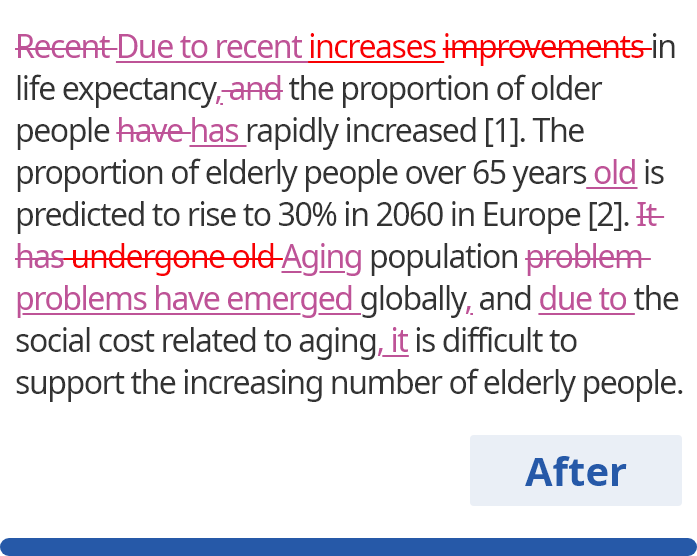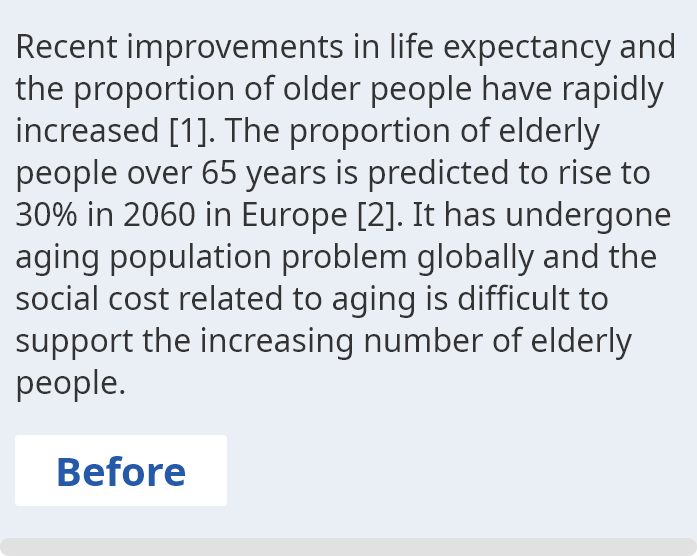주어-동사 수 일치
문장의 주어와 동사는 항상 수가 일치해야 합니다: 단수인 주어는 단수 동사와 함께 가야 하고, 복수인 주어는 복수 동사와 함께 가야 합니다. 주어와 동사를 일치시킴으로써 독자가 어떤 명사가 주어인지 헷갈리지 않게 하기 때문에 중요합니다.
- 예시
- The girl is walking in the park.
위의 문장은 간단한 문장이고, 독자들에게 문장의 주어는 "girl"라는 것은 분명합니다. 단수 동사 "is"는 단수 주어 "girl"과 수가 일치합니다.
하지만 문장이 복잡해지면 주어와 동사가 명확하지 않을 수도 있습니다. 아래의 예를 참조하세요.
- 틀린 문장
- Sample 1, in addition to Samples 2 and 3, were found to be contaminated.
- 올바른 문장
- Sample 1, in addition to Samples 2 and 3, was found to be contaminated.
여기서, 주어는 "Sample 1"이지만, 만약 문장이 복수 동사 "were"를 사용한다면, 독자들은 주어가 "Sample 1"뿐만 아니라 "Sample 2 and 3"이라고 생각할 수 있습니다.
주어동사 수일치 예시
| 동사 | 단수 주어 + 동사 | 복수 주어 + 동사 |
|---|---|---|
|
Be |
The study is novel. |
The studies are novel. |
|
Make |
He makes a cake. |
They make a cake. |
|
Conclude |
Goldmund concludes that 67% of the samples had been contaminated. |
Goldmund and Millstein conclude that 67% of the samples had been contaminated. |
|
Present |
The figure presents the results of the simulation. |
The figures present the results of the simulation. |
학술적 글쓰기에서 주어-동사 수 일치
두개 이상의 명사로 이루어진 주어와 동사 일치
문장은 동사 하나에 둘 이상의 주어를 가질 수 있습니다. 둘 이상의 명사로 이루어진 주어가 같은 동사를 공유할 때, 주어는 "and" 또는 "or"와 결합됩니다. "and"라는 접속사로 결합된 주어는 항상 복수 동사와 함께 사용됩니다.
- 틀린 문장
- Composite A and composite C was discarded due to surface irregularities.
- 올바른 문장
- Composite A and composite C were discarded due to surface irregularities.
대조적으로, 접속사 “(either…) or”로 결합된 단수 명사들로 이루어진 주어는 단수 동사와 함께 사용됩니다.
- 틀린 문장
- We concluded that either composite A or composite C have issues with surface irregularity.
- 올바른 문장
- We concluded that either composite A or composite C has issues with surface irregularity.
접속사 “(neither…)nor” 도 같은 법칙이 적용되어 단수 동사와 함께 사용됩니다.
- 틀린 문장
- Neither sample B nor sample D were found to be contaminated.
- 올바른 문장
- Neither sample B nor sample D was found to be contaminated.
그러나 결합된 명사들이 모두 복수이면 복수 동사를 사용해야 합니다.
- 틀린 문장
- Neither the patients in group A nor the patients in group B has histories of illness.
- 올바른 문장
- Neither the patients in group A nor the patients in group B have histories of illness.
때때로 복합 주어에는 단수와 복수 명사가 모두 포함될 수 있습니다. 이 경우에 동사는 가장 가깝게 위치한 명사의 수와 일치해야 합니다.
- 틀린 문장
- Neither the main frame of the vehicle nor its additional components needs to be treated with the solution.
- 올바른 문장
- Neither the main frame of the vehicle nor its additional components need to be treated with the solution.
여기서 복수 동사 "need"는 "components"가 복수 명사이기 때문에 사용됩니다.
접속사 “and” 로 연결된 주어의 더 많은 예시
"and"로 결합된 주어는 복수 동사와 함께 사용됩니다.
- 예시
- The puppy and the kitten are friends.
- 예시
- The behaviors of lipids and proteins were studied in an isolated environment.
“(either…)or” 나 “(neither…)nor” 로 연결된 주어의 예시
단수 주어 중 “(either….) or” 혹은“(neither…) nor”로 연결된 주어들은 단수형 동사를 씁니다.
- 예시
- Either the vacuum chamber or the clean room has been damaged.
- 예시
- Neither the vacuum chamber nor the clean room has been damaged.
“(either…) or”또는 “(neither…) nor”로 연결된 두 개 이상의 명사로 이루어진 주어는 복수형 동사를 씁니다.
- 예시
- Either he or she waters the plants.
- 예시
- It is rainy, so neither the park nor the beach is nice to walk on.
단수와 복수 명사를 모두 포함하는 두개 이상의 명사로 이루어진 주어들은 가장 가까운 명사가 동사와 일치됩니다. "or"나 "nor"로 연결된 명사 중 하나가 복수일 때 동사는 복수여야 하고 복수 주어를 동사 옆에 두어야 합니다.
- 예시
- Either he or his daughters water the plants.
- 예시
- Neither the clean room nor the vacuum chambers have been damaged.
주어와 떨어진 동사
많은 문장들은 주어와 동사를 떨어트려놓는 구절이나 절을 가지고 있습니다. 이 때문에 주어를 식별하기가 어려울 수 있습니다. 다음 두 예시를 보세요.
- (a)
- Many studies on this subject has neglected the effect of oxygen on the fabrication process.
- (b)
- Many studies on this subject have neglected the effect of oxygen on the fabrication process.
어느 문장이 맞을까요? 답은 b입니다. 이것은 문장의 주어가 subject"가 아니라 "studies"이기 때문입니다. 올바른 동사 형태를 사용하는 것은 독자가 문장의 주어를 더 잘 식별하는 데 도움을 줍니다.
- 틀린 문장
- We found that the derivatives of C demonstrates high heat resistance.
- 올바른 문장
- We found that the derivatives of C demonstrate high heat resistance.
정확한 복수동사를 사용함으로써, 두 번째 문장은 "derivatives"가 주어임을 명확히 합니다.
다른 연결단어: “along with,” “as well as,” “in addition to”
"along with", "as well as" 및 "in addition to"와 같은 문구는 접속어는 아니지만 연결해 주는 역할을 합니다. 위에서 언급했듯이, 접속사 "and"로 결합된 주어는 항상 복수 동사와 함께 사용됩니다. 이는 "along with", "as well as" 및 "in addition to"의 경우는 해당되지 않습니다.
- 틀린 문장
- Composite C, along with composite A, were discarded due to surface irregularities.
- 올바른 문장
- Composite C, along with composite A, was discarded due to surface irregularities.
- 틀린 문장
- Composite C as well as composite A were discarded due to surface irregularities.
- 올바른 문장
- Composite C as well as composite A was discarded due to surface irregularities.
- 틀린 문장
- Composite C, in addition to composite A, were discarded due to surface irregularities.
- 올바른 문장
- Composite C, in addition to composite A, was discarded due to surface irregularities.
이렇게 연결된 구문은 두 개 이상의 명사를 합쳐서 주어를 만들지 않는다는 점에서 "and"과 다릅니다. 위의 문장에서 주어는 "composite C"이고, "composite C, along with composite A," 또는 "composite C, in addition to composite A."는 주어가 아닙니다.
부정 대명사
또 다른 흔한 혼란은 "Anything"과 같은 부정 대명사가 단수 동사와 함께 사용되어야 하는지 아니면 복수 동사와 함께 사용되어야 하는지입니다. 일부 부정 대명사는 항상 단수로 취급되는 반면, 어떤 대명사는 항상 복수형으로 취급됩니다. 어떤 부정 대명사들은 문장에 따라 단수 또는 복수로 취급될 수 있습니다. 흔히 쓰는 부정 대명사: all, any, anything, anybody, anyone, anywhere, every, everything, everybody, everyone, everywhere, some, something, somebody, someone, somewhere, none, nothing, nobody, nowhere, more, most, another, each, one, both, either, few, many, several
대부분의 부정 대명사는 단수로 취급됩니다. "Every," "other," "each," 그리고 "one"이나 "thing","body" 혹은 "where"로 끝나는 모든 무한 대명사는 단수 동사와 함께 사용됩니다.
- 예시
- Every sample was treated with the prepared solution.
- 예시
- Another girl asks for paper.
- 예시
- Each of the samples was treated with the prepared solution.
- 예시
- Only one of the boys wants ice cream.
- 예시
- Something is wrong.
반면에, “both,” “few,” “many,” 그리고 “several” 는 복수로 취급합니다.
- 예시
- Both of the samples were contaminated with ammonia.
- 예시
- Few are happy with the results.
- 예시
- We found that many of the composites were damaged by exposure to air.
- 예시
- Several children look for extra pencils.
몇몇의 부정대명사는 문장에 따라 단수 또는 복수 중 하나로 취급됩니다. 이들은 “all,” “some,” “any,” “none,” “more,” “most,” and “either”입니다. 다음 문장들은 부정대명사 "some"을 사용한 예문입니다.
- 예시
-
Some of the samples were contaminated.
Some of the sample was contaminated.
첫 번째 문장에서, "some"은 복수이고 복수 동사와 함께 사용되어야 하는 "samples"을 가리킵니다. 두 번째 문장에서, "some"은 단수이고 단수 동사와 함께 사용되어야 하는 "sample"을 가리킵니다.
동사 뒤에 오는 주어
주어가 동사 뒤에 오는 문장이 있습니다. 이렇게 반전된 문장 구조를 가진 문장뿐만 아니라 "there" 또는 "here"로 시작하는 문장에도 해당됩니다.
- 예시
- There are five equations that must be considered.
- 예시
- Here is an equation that must be considered.
- 예시
- Behind the building stands a trash can.
위의 예에서 볼 수 있듯이, 동사 뒤에 주어가 오는 문장에서도 동일한 주어-동사 수 일치 규칙이 적용됩니다.
숫자, 백분율 및 금액
때때로 문장의 주어는 숫자 또는 수량일 수 있고 이는 특히 학술적 글쓰기에서 흔합니다. 숫자 값은 일반적으로 과학 연구에 중요하기 때문입니다. 숫자가 주어로 사용될 때 동사 형태는 숫자가 무엇을 가리키는지에 따라 달라집니다.
- 예시
- 67% of the samples were found to be contaminated.
- 예시
- 80 cm of electric tape was cut.
"67%"는 "samples"을 의미합니다. 그러므로, 그것은 복수 동사인 "were"와 함께 사용되어야 합니다. 반면에, "80 cm"는 "electrical tape"를 가리킵니다. 이것은 단수 동사 "was"와 함께 사용되어야 합니다. 비율도 마찬가지의 규칙이 적용됩니다.
- 예시
- Almost three-quarters of the samples were found to be contaminated.
- 예시
- Almost three-quarters of the first sample was found to be contaminated.
만약 주어가 무언가의 합쳐진 양을 표시한다면, 그것은 단수로 취급되어야 합니다.
- 예시
- 70 cm is not a sufficient length.
- 예시
- 97.5% is a high accuracy that has not been previously achieved.
주어가 되는 집합 명사
집합 명사는 사람, 동물 또는 사물 무리의 그룹을 가리키는 명사입니다. 이러한 명사와 함께 사용되어야 하는 동사 형태는 미국식인지 영국식인지에 따라 다릅니다. 집합 명사는 일반적으로 미국 영어에서는 단수로 취급되지만 영국 영어에서는 복수형으로 취급됩니다.
- 예시
- (US) The flock flies to Russia in early summer.
- 예시
- (UK) The flock fly to Russia in early summer.
"A flock"는 새들의 무리입니다. 미국 영어 관습에 따르면, "flock"은 단수 동사와 함께 사용되어야 합니다. 반면에, 영국 영어 관습은 "떼"를 복수 동사와 함께 사용할 것을 요구합니다. 이것은 미국영어가 떼의 단결을 강조하는 반면 영국영어는 떼를 구성하는 많은 새들을 강조하기 때문입니다.
강조하는 것이 무엇인지에 따라 집합 명사를 단수로 여길지 복수로 여길지가 달라집니다.
- 예시
- The flock squawk at each other.
- 예시
- The flock is enormous.
위의 두 가지 예는 문장의 내용 때문에 미국과 영국 영어 모두에 적용됩니다.
주어가 되는 셀 수 없는 명사
셀 수 없는 명사는 추상적인 개념이나 일반적인 용어이므로 셀 수 없습니다. 셀 수 없는 명사의 예: research, information, progress, equipment, furniture, luggage, flour, cement. 셀 수 없는 명사는 항상 단수 취급합니다.
- 예시
- The research found the previous results to be invalid.
- 예시
- Information is a strategic resource.
- 예시
- The cement was poured over the foundation.
주어가 되는 두문자어 및 약어
두문자어 및 약어의 규칙은 간단합니다. 두문자어/약어가 어떤 단어를 줄였는지 확인하세요. 먼저 전체 버전이 단수, 복수, 복합 또는 집합인지 확인한 다음 그에 따라 규칙을 적용합니다.
- 예시
- This new SSD is perfect for my PC.
“SSD” 는 “solid-state drive”의 약어로 단수이므로 동사도 단수 동사를 씁니다.
- 예시
- BCS continue to experience the side effects of the treatments they were exposed to.
“BCS” 는 “breast cancer survivors,” 를 의미하고, 이들은 복수형이므로 동사도 복수형을 써야 합니다.





